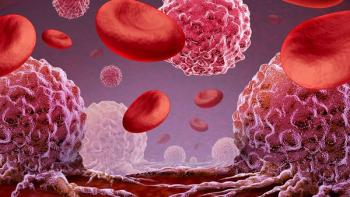
Second-Line Enhertu May Be ‘Standard of Care’ for Patients with HER2-Positive Metastatic Breast Cancer
The use of Enhertu may also be beneficial across HER2-positive metastatic breast cancer subgroups including patients with and without brain metastases.
Second-line therapy with Enhertu (fam-trastuzumab deruxtecan-nxki) prolonged survival and led to higher responses compared with Kadcyla (ado-trastuzumab emtansine) in patients with HER2-positive metastatic breast cancer across all patient subgroups, including those with and without brain metastases at the start of the study, according to recent findings from an analysis.
The results of the analysis of the phase 3 DESTINY-Breast03 trial, which were presented at the 2021 San Antonio Breast Cancer Symposium, demonstrated a progression-free survival (time during and after treatment when the patient lives without disease progression) of 15 months with Enhertu compared with three months with Kadcyla in patients with brain metastases at the beginning of the study. This survival analysis was performed at a median follow up of 15.9 months. The 12-month progression-free survival rates were 72% and 20.9%, respectively.
The median progression-free survival was not evaluable with Enhertu (meaning that more than half of patients were alive when this was assessed) compared with 7.1 months with Kadcyla in patients without brain metastases. The 12-month progression-free survival rates were 76.5% versus 36.4%, respectively.
“These data support (Enhertu) becoming the standard of care for the second-line treatment of patients with HER2-positive metastatic breast cancer,” Dr. Sara A. Hurvitz, lead study author and associate professor at the David Geffen School of Medicine at the University of California Los Angeles, said in a presentation of the data.
In this trial, 524 patients with HER2-positive metastatic breast cancer who were previously treated with Herceptin (trastuzumab) and a taxane were randomized to receive either Enhertu (median age, 54.3 years) or Kadcyla (median age, 54.2 years). Patients with clinically stable, treated brain metastases were eligible for enrollment.
Notably, Asian patients represented the majority of patients enrolled in the study, at 57.1% in the Enhertu group versus 60.8% in the Kadcyla group.
The primary goal of the study was assessing progression-free survival, with secondary goals including measuring overall survival (the time when a patient with cancer is still alive), objective response rate (the rate of a measurable response to treatment), duration of response (the time a tumor responds to treatment without growth or spread) and safety.
When researchers cut off data for analysis, 32.2% of patients in the Enhertu group versus 58.9% of patients in the Kadcyla group had progressive disease (cancer that grew, spread or worsened).
The median overall survival was not evaluable in either group, and the 12-month overall survival rates were 94.1% versus 85.9%, respectively.
Moreover, the confirmed objective response rate was 79.7% with Enhertu compared with 34.2% with Kadcyla; the complete response (the disappearance of cancer as a response to treatment) rates were 16.1% versus 8.7%, respectively.
Updated findings demonstrated that the progression-free survival and confirmed objective response rate data also favored Enhertu across patient subgroups: hormone receptor status (positive versus negative), prior Perjeta (pertuzumab) treatment, visceral disease, prior lines of therapy and patients with brain metastases.
“Over 67% of patients in each subgroup had an objective response with (Enhertu), with most (patients in each subgroup) exceeding three-quarters of patients having an objective response,” said Hurvitz.
Among patients with brain metastases, the confirmed objective response rate was 67.4% with Enhertu and 20.5% with Kadcyla. Among patients without brain metastases, the confirmed objective response rate was 82.1% versus 36.6%, respectively.
Notably, patients with brain metastases experienced a lower rate of progressive disease with Enhertu compared with Kadcyla, at 48.8% versus 69.2%, respectively.
Regarding intracranial responses, the complete response rate was 27.8% with Enhertu and 2.8% with Kadcyla. The intracranial partial response rates (a decrease in tumor size or the amount of cancer in the body as a response to treatment) were 36.1% versus 30.6%, respectively. The use of Enhertu also led to a lower rate of intracranial progressive disease versus Kadcyla, at 2.8% versus 22.2%, respectively.
“These data regarding the intracranial objective response are very intriguing and exciting, but we need larger studies that are ongoing to look at the activity of (Enhertu) in untreated and actively progressing brain metastases,” said Hurvitz, stating that currently there is minimal evidence in Tukysa (tucatinib) as a treatment option for patients with brain metastases in need of second-line therapy.
Regarding safety, treatment-related side effects occurred in 99.6% of patients on Enhertu versus 95.4% of patients on Kadcyla. Severe or worse side effects occurred in 52.1% versus 48.3% of patients, respectively. Despite this, the incidence rates of side effects, when taking exposure to treatments into consideration, were lower with Enhertu than Kadcyla.
The median treatment duration was 14.3 months with Enhertu and 6.9 months with Kadcyla.
Treatment-related side effects leading to discontinuation occurred in 13.6% of patients on Enhertu versus 7.3% of patients on Kadcyla. These rates were similar when exposure to treatment was taken into consideration.
Most side effects were hematologic or gastrointestinal in nature. The most common severe or worse side effects with Enhertu were low white blood cell count (19.1%), low blood platelet count (7%), nausea (6.6%), leukopenia (decrease in cells that fight disease; 6.6%) and anemia (5.8%). The most common severe or worse side effects with Kadcyla were low blood platelet count (24.9%), liver damage (5%), alanine aminotransferase increase (4.6%) and anemia (4.2%).
Regarding interstitial lung disease/pneumonitis, side effects of any severity occurred in 10.5% of patients on Enhertu versus 1.9% of patients on Kadcyla, which was comparable to the rates that were reported in the Asian (10.9% versus 2.5%, respectively) and non-Asian (10% versus 1%, respectively) patients.
No life threatening or fatal related interstitial lung disease /pneumonitis occurred with Enhertu.
This article originally appeared on OncLive as “
For more news on cancer updates, research and education, don’t forget to





